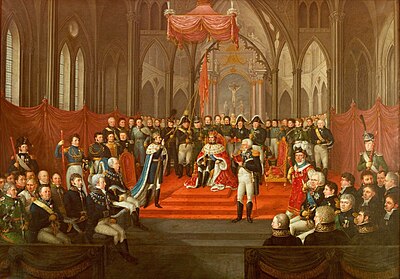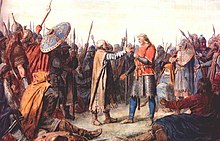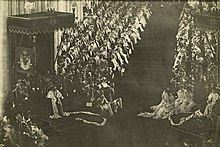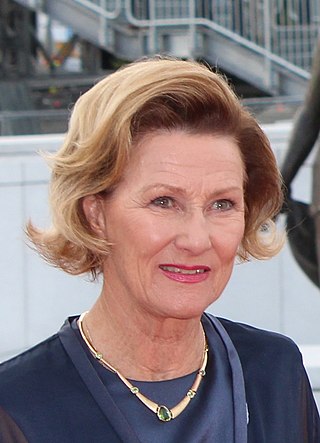
Sonja is Queen of Norway as the wife of King Harald V.

Nidaros Cathedral is a Church of Norway cathedral located in the city of Trondheim in Trøndelag county. It is built over the burial site of King Olav II, who became the patron saint of the nation, and is the traditional location for the consecration of new kings of Norway. It was built over a 230-year period, from 1070 to 1300 when it was substantially completed. However additional work, additions and renovations have continued intermittently since then, including a major reconstruction starting in 1869 and completed in 2001.
Nidaros, Niðarós or Niðaróss was the medieval name of Trondheim when it was the capital of Norway's first Christian kings. It was named for its position at the mouth of the River Nid.

The Battle of Stiklestad in 1030 is one of the most famous battles in the history of Norway. In this battle, King Olaf II of Norway was killed. During the pontificate of Pope Alexander III, the Roman Catholic Church declared Olaf a saint in 1164.

An enthronement is a ceremony of inauguration, involving a person—usually a monarch or religious leader—being formally seated for the first time upon their throne. Enthronements may also feature as part of a larger coronation rite.

The regalia of Norway are items that symbolise the Norwegian monarch's power and majesty. Little is known of the old Norwegian regalia which have since been lost. The majority of the modern regalia date from 1818 and were made for the coronation of Jean Bernadotte as King Carl III Johan.
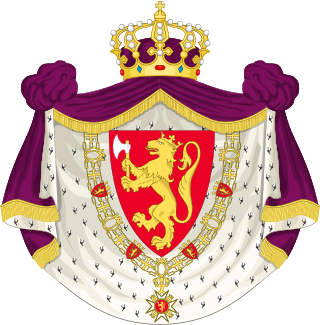
The Norwegian monarch is the head of state of Norway, which is a constitutional and hereditary monarchy with a parliamentary system. The Norwegian monarchy can trace its line back to the reign of Harald Fairhair and the previous petty kingdoms which were united to form Norway; it has been in unions with both Sweden and Denmark for long periods.

The Crown of Norway is the crown of the King of Norway and was made in Stockholm in 1818 by goldsmith Olof Wihlborg. The crown is a corona clausa consisting of a ring carrying eight hoops made of gold and surmounted by a monde of blue enamel and an amethyst cross on top of it. The crown is decorated with many pearls and gemstones including amethysts, chrysoprases, a topaz and an alexandrite. Its front is adorned with a huge green tourmaline, a gift of the Brazilian consul in Stockholm to King Charles III Johan. Its splendid colours and its richly elaborated ornaments make the crown typical of the Empire period. Although the goldsmith work was carried out by Olof Wihlborg, it is not known who designed the crown.

A referendum on retaining the monarchy or becoming a republic was held in Norway on 12 and 13 November 1905. Voters were asked whether they approved of the Storting's decision to authorise the government to make the offer of the throne of the newly self-ruling country. The Storting had wanted to offer the throne to Prince Carl of Denmark, but the prince insisted that the Norwegian people have a chance to decide whether they wanted to retain a monarchy.

Olav Engelbrektsson was the 28th Archbishop of Norway from 1523 to 1537, the Regent of Norway from 1533 to 1537, a member and later president of the Riksråd, and a member of the Norwegian nobility. He was the last Roman Catholic to be the Archbishop of Norway before he fled to exile in 1537.

The accession of the King of France to the royal throne was legitimized by a ceremony performed with the Crown of Charlemagne at the Reims Cathedral. In late medieval and early modern times, the new king did not need to be anointed in order to be recognized as French monarch but ascended upon the previous monarch's death with the proclamation "Le Roi est mort, vive le Roi!"

The coronation of the emperor of Russia from 1547 to 1917, was a highly developed religious ceremony in which they are crowned and invested with regalia, then anointed with chrism and formally blessed by the church to commence his reign. Although rulers of Muscovy had been crowned prior to the reign of Ivan III, their coronation rituals assumed overt Byzantine overtones as the result of the influence of Ivan's wife Sophia Paleologue, and the imperial ambitions of his grandson, Ivan the Terrible. The modern coronation, introducing "Western European-style" elements, replaced the previous "crowning" ceremony and was first used for Catherine I in 1724. Since tsarist Russia claimed to be the "Third Rome" and the replacement of Byzantium as the true Christian state, the Russian rite was designed to link its rulers and prerogatives to those of the so-called "Second Rome" (Constantinople).

Napoleon and Joséphine were crowned Emperor and Empress of the French on Sunday, December 2, 1804, at Notre-Dame de Paris in Paris. It marked "the instantiation of [the] modern empire" and was a "transparently masterminded piece of modern propaganda".

Johannes Smemo was a Norwegian theologian, psalmist, and a long-time bishop in the Church of Norway. Theologically, he was a conservative, confessional Lutheran priest who lived during the time of great liberal-conservative debates within the Church of Norway.

Coronations were previously held in the monarchies of Europe. The United Kingdom is the only monarchy in Europe that still practises coronation. Other European monarchies have either replaced coronations with simpler ceremonies to mark an accession or have never practised coronations. Most monarchies today only require a simple oath to be taken in the presence of the country's legislature.
St. Olav’s Shrine was the resting place of the earthly remains of St. Olav, Norway’s patron saint, behind the high altar of Nidaros Cathedral in Trondheim, Norway, from the mid 11th century. For nearly five centuries the shrine was of major religious importance to Norway and the other Nordic countries, and also to other parts of Northern Europe. St. Olav’s Shrine opens and closes the Middle Ages as a historic period in Norway. The shrine consisted of three shrines, the one covering the other, and was the most important and by far the most valuable object in Norway in the Middle Ages. After the Lutheran reformation in 1536–1537, the valuable parts of St. Olav’s Shrine were destroyed by Danish authorities. Since 1568 St. Olav’s earthly remains have been resting in an unknown grave, in Nidaros Cathedral or in the cathedral cemetery.
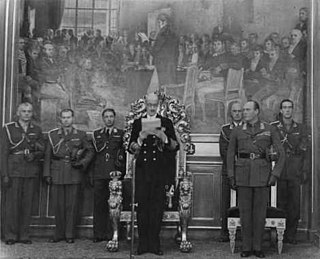
The throne of Norway are the physical representations of the monarchy of Norway. One stands in the building of the Parliament in Oslo, the political capital of Norway, where it is used in a political context. The other stands in Trondheim, the religious capital of Norway, where it was used in a religious context. Lesser known is the throne in the Council Chamber in the Royal Palace. In addition to the thrones, there are two coronation chairs, which are also located in Trondheim. Between 1671 and 1814, the Coronation Chair of Denmark was de facto also Norway's.

The coronation of the Danish monarch was a religious ceremony in which the accession of the Danish monarch was marked by a coronation ceremony. It was held in various forms from 1170 to 1840, mostly in Lund Cathedral in Lund, St. Mary's Cathedral in Copenhagen and in the chapel of Frederiksborg Palace in Hillerød.

The Coronation of the Emperor of Brazil was the religious act of consecration during which the monarchs of the Empire of Brazil were solemnly blessed, anointed, crowned, invested with the other items of the imperial regalia and enthroned, according to the usages of the Catholic Church, the Empire's official, established Church. The coronation of the Brazilian monarch confirmed the accession of a new emperor to the throne, and corresponded to similar rites that took place in other Christian monarchies. The two Brazilian emperors, Pedro I and Pedro II underwent the ceremony of coronation, on 1 December 1822 and 18 July 1841, respectively. Those remain the two sole acts of coronation that took place in the South American continent.

Coronations of the Swedish monarchs took place in various cities during the 13th and 14th centuries, but from the middle of the 15th century onward in the cathedrals of Uppsala or Stockholm, with the exception of the coronation of Gustav IV Adolf, which took place in Norrköping in 1800. Earlier coronations were also held at Uppsala, the ecclesiastical center of Sweden. Prior to Sweden's change to a hereditary monarchy, the focus of the coronation rite was on legitimising an elected king.
